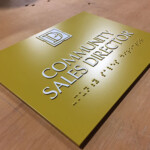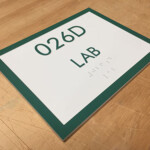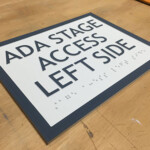Photopolymer ADA Signs
Photopolymer signs are made by a solid one piece construction technique that is requested due to its durability and tamper proof nature.
Identification: Interior Photopolymer Signs are truly a one-piece construction. They can easily be identified by ensuring that the raised lettering is physically attached (not laminated) to the face plate. The edges of the raised lettering will be the same color as the face plate, and only the face of the raised lettering will be a separate color.
Production: The Photopolymer process utilizes a polymer material that is light sensitive. It is supplied as a clear blank slate. Negatives are printed off with the lettering, pictograms and Braille left clear. The material is exposed with the negatives on top, curing the clear areas of the raised graphics.
It then goes through a cleaning process, which washes away all non-exposed areas, leaving the text, Braille, and pictograms raised. After being cleansed, the entire sign is exposed again, curing the entire sign. It is then surface painted (with the edges painted). Subsurface paint or print is also available through slight deviation of the process.
After being painted, it goes through a screen printing process called “tipping” or “hot stamping” where just the tips of the raised characters are “tipped” a separate color. Finally, the sign is often clear coated, ensuring that the screened area has a non-glare finish, as well as providing an extra layer of protection to the ink and paint.
Advantages: Photopolymer signs are very durable with even the Braille being a physical part of the face plate. They are great for school systems, correctional facilities, and any other area where they may be subject to tampering. If you’re looking for durability, this is your best choice.
Disadvantages: The photopolymer process is a delicate process, which makes these signs difficult to produce in a limited time frame. Sizes are also limited to 18”x24” for interior and 19”x29” for exterior.
Environment: The PETG core is made of 40% post industrial recycled material and all of the materials used in the manufacturing process are readily recyclable and/or biodegradable.
Add-ons: UHB Tape for mounting, Holes Drilled/Countersunk for Mounting, Radius Corners, Beveled Edges, Accent Bars, Back Plates, Cubicle Hangers, Window Areas for Paper Inserts, Conference Sliders, Wood Laminates, Metal Laminates, Inserted in Frames, and many more!







